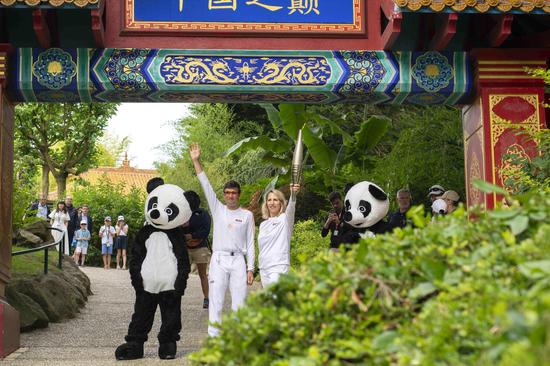By Lin Yanhua and Lin Hao from China News Service
The Chinese painting Hundred Miles of the Lijiang River was presented by the Embassy of the People’s Republic of China in the United States of America to then U.S. President George Herbert Walker Bush as a state gift. Subsequently, it was collected by the Library of Congress. The painting’s creator, Professor Huang Gesheng, once served as the Vice Chairman of the China Artists Association, the Vice Chairman of the Central Committee of the China Zhi Gong Party, and the President of the Association for the Promotion of Lijiang Painting School. Professor Huang later conducted an academic lecture in the United States upon invitation, making him the first Chinese artist to elucidate Chinese painting culture at the Library of Congress.
In the face of a diverse cultural landscape, how can Chinese painting, this unique art form, be shared with the world to enable more people to appreciate the ink and brush spirit within traditional Chinese culture and facilitate cultural exchange between the East and the West? Recently, Professor Huang Gesheng sat down for an exclusive interview with the “W. E. Talk” of the China News Service to discuss this topic.
Here are excerpts from the interview:
CNS: How did you learn and develop a passion for Chinese painting? What are the distinctive characteristics of Chinese painting, and what is its essence?
Huang Gesheng: My interest in fine arts is innate. I started doodling on mud walls as soon as I could stand up and walk. 72 years old, I’m still painting. Painting has always been a passion I ardently pursue.
Chinese painting is created using a brush dipped in water, ink, and colors on silk or paper, reflecting the ancients’ understanding of nature, society, and their connections with politics, philosophy, religion, morality, literature, and nature, among others.
Chinese painting encompasses profound knowledge in literature, calligraphy, history, philosophy, politics, and sociology, and showcases the breadth of Chinese culture. It serves as a “business card” that represents the good image of the Chinese nation. It can depict the characteristics and beauty of different periods in Chinese history, embodying the insights, character, psychology, and temperament of the Chinese people.
The long scroll Along the River During the Qingming Festival by the Northern Song Dynasty painter Zhang Zeduan is a vivid portrayal of the cityscape of the capital city, Dongjing (also known as Bianjing, today’s Kaifeng in Henan), and the life of people from all sectors of society. It is an unparalleled masterpiece in the history of Chinese and even global painting, now recognized as a national treasure with significant historical and artistic value.
Chinese painting, as it has evolved, encompasses various genres and styles from different artists and schools. It has gradually formed three major painting categories: landscapes, figures, and flowers and birds. Chinese painting possesses unique artistic expressions and aesthetic features, making it an essential component of the fine traditional Chinese culture.
CNS: How was the 200-meter-long Chinese painting scroll Hundred Miles of the Lijiang River created?
Huang Gesheng: The success of this painting went beyond my expectations, but I was also confident of it. Back then, if I had done it for the sake of fame and fortune, the painting would have been impossible.
The story began with a publishing house looking for traditional Chinese painting to depict the Lijiang River. As a native of Guilin, I readily accepted this task. During creation, I found that there was no complete work that truly captured the charm of the beautiful landscapes of the Lijiang River. This inspired the idea to create a long scroll.
It didn’t take me too much time to paint it, but I spent approximately three years preparing for it. I traveled to and fro along the Lijiang River dozens of times, using various means such as walking, biking, and boating. I made over a thousand sketches. In the end, relying on my memory and a comprehensive understanding of the river, I completed whole the painting in one go.
CNS: The Hundred Miles of the Lijiang River has had a significant impact. Why could it be used as a state gift for cultural exchanges and subsequently collected by the Library of Congress?
Huang Gesheng: I never expected that this album could be used as a state gift for two U.S. presidents. Later, the United States Library of Congress sent representatives to Guangxi to learn about its creation process and brought it back to the United States for further study. Soon after, they invited me to give a lecture on the history of Chinese painting and the creative process behind this work. After attending the lecture, the then Librarian of the Library of Congress held Chinese painting art in high regard.
The fact that this album was presented as a state gift for cultural exchanges can be attributed to two factors: firstly, the unparalleled beauty of the Lijiang River’s landscapes. These landscapes are celebrated as some of the most magnificent in the world. Despite traveling to many scenic spots globally, I always hold the view that the scenery along the Lijiang River is among the most beautiful. Westerners believe that this painting effectively captures the beauty of the river’s landscapes and serves as a representative piece, which is what sparked their interest in collecting it.
Secondly, Western countries’ growing interest in understanding Chinese traditional culture and art amid China’s accelerated opening up to the outside world.
When I first went to the United States in the mid-1980s, China’s economic development was not at a high level, and Westerners didn’t have a deep understanding of Chinese culture. In comparison to artworks by Western painters, some masterpieces of Chinese painters were remarkably affordable. Some Westerners even asked me, “Did China learn its culture from Japan?”
As China’s comprehensive national strength grows, the Western world has gradually come to recognize the value of Chinese traditional art forms like Chinese painting. This recognition has sparked an increased interest in understanding and learning about them. The status of Chinese painting in the global art scene has been on the rise, and the value of Chinese artworks has been steadily increasing.
Chinese painting artworks, though they may be just a small piece of paper, hold immense value due to the depth of Chinese culture and the historical significance they carry. Each painting is unique and irreplaceable, crafted through the artist’s long-term dedication and practice.
CNS: What differences do you see between Chinese and Western paintings, and do you think Chinese painting should conform to Western aesthetic principles?
Huang Gesheng: In the 20th century, there was a trend of “using Western painting to transform Chinese painting.” Western-style sketching temporarily replaced the traditional comprehensive training in Chinese painting that combines both technique and artistic essence. Some artists even advocated the idea of using Western painting to reform Chinese painting.
While creating the Hundred Miles of the Lijiang River, I did contemplate whether to depict the Lijiang River in a Western abstract style or to utilize the traditional Chinese realistic approach. After careful consideration, I chose the latter.
Chinese culture is a vast and unique system. In comparison to Western culture, it possesses distinct characteristics. These cultures cannot replace each other, but they can certainly influence each other. Chinese painting, as a part of the fine traditional Chinese culture, follows a relatively stable pattern of development and rhythm. It shouldn’t change its course based on Western preferences.
We can certainly learn from Western painting when it comes to aspects like form and color expression. It’s a way to supplement our own shortcomings. However, we should avoid blindly copying or imitating the entire cultural context of a foreign land.
CNS: How can traditional Chinese painting innovate and develop more effectively in the present times?
Huang Gesheng: Traditional Chinese painting should evolve with the times and inherit excellent elements from tradition.
Innovations in Chinese painting should focus on creating new thematic ideas and content and generating fresh artistic concepts and spirits, rather than relying merely on finding new subject matter or working in isolation to develop unique techniques.
Faced with a diverse cultural landscape, Chinese painting should maintain the purity of brush and ink. Young artists should delve deeper into traditional culture, and enhance self-cultivation and artistic aesthetic abilities, thereby creating new stylistic characteristics.
Artists must wholeheartedly devote themselves, be willing to endure solitude, diligently practice brushwork and composition, enhance their literary and artistic cultivation, and judiciously incorporate new materials. Only then can they contribute to the innovative development of Chinese painting.
CNS: As the head of the Lijiang Painting School, how do you believe the school can better showcase the essence of traditional Chinese painting and promote international artistic exchange and cooperation?
Huang Gesheng: Art is not an ivory tower; it is closely connected to social life. It uses its unique language to record and reflect historical changes.
The Lijiang Painting School was established following the creation of the Hundred Miles of the Lijiang River. This school of painting is characterized by its emphasis on sketching and lifelike representation. It exhibits the typical southern style with warmth, tranquility, vividness, a sense of family, grandeur, and openness.
As a regional school of painting, our artists should first and foremost dedicate themselves to creating works that reflect the unique characteristics of Guangxi. This will enable their pieces to better demonstrate the charm of Guangxi and embody the essence of traditional Chinese painting.
Fine art is a universal language that knows no boundaries. Advancing international artistic exchanges can convey China’s goodwill and help dispel misunderstandings. Guangxi, being geographically close to ASEAN countries and sharing cultural ties, is actively working to establish the Lijiang Painting School as an internationally renowned art brand. This effort aims to promote cooperation and exchanges between Guangxi and countries and regions along the Belt and Road, with a particular focus on ASEAN countries.
In recent years, with the support of Guangxi Arts University, I have advocated for the establishment of China’s first undergraduate college named after “Chinese Painting” – Academy of Chinese Painting of Guangxi Arts University. This institution has nurtured thousands of students who are in different parts of the world.
The Lijiang Painting School has organized activities like the “Malaysia-Guangxi Cultural Boat - Lijiang Painting School Masterpieces Exhibition” and the “Lijiang Painting School Silk Road Journey”, introducing a series of outstanding artworks. Artists from the school have also traveled to countries such as Cambodia, Thailand, and the Republic of Korea to draw inspiration, engage in artistic exchanges, and promote traditional Chinese ink painting.
Going forward, the Lijiang Painting School plans to organize art exhibitions in countries along the Belt and Road, with a focus on ASEAN countries to facilitate Guangxi’s role as a bridge and link in the cultural exchanges and cooperation between China and ASEAN countries in the field of art.
About the interviewee:
Huang Gesheng, male, currently serves as the President of the Association for the Promotion of Lijiang Painting School. He has previously held positions such as Vice Chairman of the China Artists Association, Vice Chairman of the Central Committee of the China Zhi Gong Party, and President of Guangxi Arts University. He has also exhibited his artworks in countries such as the United States and the Netherlands, and regions like China’s Taiwan Province. He has published over 40 collections and albums of his paintings. His renowned masterpiece is the Chinese painting scroll Hundred Miles of the Lijiang River, and his painting Lijiang River Amidst Misty Rain once traveled into space aboard Shenzhou VI manned spacecraft.


















































 京公网安备 11010202009201号
京公网安备 11010202009201号